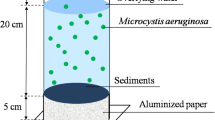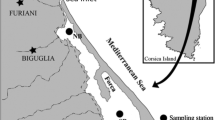Abstract
We studied extracellular acid phosphatase activity (AcPA) of planktonic microorganisms, aluminium (Al) speciation, and phosphorus (P) cycling in three atmospherically acidified (pH of 4.5–5.1) mountain forest lakes: Čertovo jezero (CT), Prášilské jezero (PR), and Plešné jezero (PL) in the Bohemian Forest (Šumava, Böhmerwald). Microorganisms dominated pelagic food webs of the lakes and crustacean zooplankton were important only in PR, with the lowest Al concentrations (193 µg L−1) due to 3–4 times lower terrestrial input. The lakes differed substantially in Al speciation, i.e., in the proportion of ionic and particulate forms, with the highest proportion of ionic Al in the most acid CT (pH = 4.5). The P concentration in the inlet of PL (mean: 22.9 µg L−1) was about five times higher than in CT and PR (3.9 and 5.1 µg L−1, respectively). Average total biomass of planktonic microorganisms in PL (593 µg C L−1) was, however, only ∼2-times higher than in CT and PR (235 and 272 µg C L−1, respectively). Enormous AcPA (means: 2.17–6.82 µmol L−1 h−1) and high planktonic C : P ratios suggested severe P limitation of the plankton in all lakes. Comparing 1998 and 2003 seasons, we observed changes in water composition (pH and Al speciation) leading to a significant increase in phytoplankton biomass in the lakes. The increase in the seston C : P ratio during the same time, however, indicates a progressive P deficiency of the lakes. The terrestrial Al inputs, together with in-lake processes controlling the formation of particulate Al, reduced P availability for planktonic microorganisms and were responsible for the differences in AcPA. At pH < 5, moreover, ionic Al forms caused inhibition of extracellular phosphatases. We postulate that both particulate and ionic Al forms affect P availability (i.e., inhibition of extracellular phosphatases and inactivation of P), specifically shape the plankton composition in the lakes and affect plankton recovery from the acid stress.
Similar content being viewed by others
References
Bittl, T., Vrba, J., Nedoma, J. & Kopáček, J. 2001. Impact of aluminium on extracellular phosphatases in acidified lakes. Environ. Microbiol. 3: 578–587.
Blomquist, P., Bell, R.T., Olofsson, H., Stensdotter, U. & Vrede, K. 1993. Pelagic ecosystem responses to nutrient addition in acidified and limed lakes in Sweden. Ambio 22: 283–289.
Brakke, D.F., Baker, J.P., Böhmer, J., Hartmann, A., Havas, M., Jenkins, A., Kelly, C., Ormerod, S.J., Paces, T., Putz, R., Rosseland, B.O., Schindler, D.W. & Segner, H. 1994. Group report: Physiological and ecological effects of acidification on aquatic biota, pp. 275–312. In: Steinberg, C.E.W. & Wright, R.F. (eds) Acidification of freshwater ecosystems: Implications for the future, Wiley, Chichester.
Driscoll, C.T. 1985. Aluminum in acidic surface waters: Chemistry, transport, and effects. Environ. Health Persp. 63: 93–104.
Exley, C. 2003. A biogeochemical cycle for aluminium? J. Inorg. Biochem. 97: 1–7.
Fott, J., Pražáková, M., Stuchlík, E. & Stuchlíková, Z. 1994. Acidification of lakes in Šumava (Bohemia) and in the High Tatra Mountains (Slovakia). Hydrobiologia 274: 37–47.
Havas, M. & Rosseland, B.O. 1995. Response of zooplankton, benthos, and fish to acidification: an overview. Water Air Soil Pollut. 85: 51–62.
Hecky, R.E., Campbell, P. & Hendzel, L.L. 1993. The stoichiometry of carbon, nitrogen, and phosphorus in particulate matter of lakes and oceans. Limnol. Oceanogr. 38: 709–724.
Hejzlar, J., Kopáček, J., Vrba, J., Komárková, J. & Šimek, K. 1998. Limnological study of Plešné Lake in 1994–1995. Silva Gabreta 2: 155–174.
Hörnström, E., Ekström, C. & Duraini, O. 1984. Effects of pH and different levels of aluminium on lake plankton in the Swedish west coast area. Rep. Inst. Freshwater Res., Drottningholm 61: 115–127.
Hörnström, E., Harbom, A., Edberg, F. & Andrén, C. 1995. The influence of pH on aluminium toxicity in the phytoplankton species Monoraphidium dybowskii and M. griffithii. Water Air Soil Pollut. 85: 817–822.
Jansson, M. 1981. Induction of high phosphatase activity by aluminum in acid lakes. Arch. Hydrobiol. 93: 32–44.
Jansson, M., Blomqvist, P., Jonsson, A. & Bergström, A.-K. 1996. Nutrient limitation of bacterioplankton, autotrophic and mixotrophic phytoplankton, and heterotrophic nanoflagellates in Lake Örträsket. Limnol. Oceanogr. 41: 1552–1559.
Jansson, M., Persson, G. & Broberg, O. 1986. Phosphorus in acidified lakes: The example of Lakes Gardsjön, Sweden. Hydrobiologia 139: 81–96.
Joseph, E.M., Morell, F.M.M. & Price, N.M. 1995. Effects of aluminum and fluoride on phosphorus acquisition by Chlamydomonas reinhardtii. Can. J. Fish. Aquat. Sci. 52: 353–357.
Kopáček, J., Brzáková, M., Hejzlar, J., Nedoma, J., Porcal, P. & Vrba, J. 2004. Nutrient cycling in a strongly acidified mesotrophic lake. Limnol. Oceanogr. 49: 1202–1213.
Kopáček, J., Hejzlar, J., Borovec, J., Porcal, P. & Kotorová, I. 2000a. Phosphorus inactivation by aluminum in the water column and sediments: A process lowering in-lake phosphorus availability in an acidified watershed-lake ecosystem. Limnol. Oceanogr. 45: 212–225.
Kopáček, J., Hejzlar, J., Kaňa, J., Porcal, P. & Klementová, Š. 2003. Photochemical, chemical, and biological transformations of dissolved organic carbon and its impact on alkalinity production in acidified lakes. Limnol. Oceanogr. 48: 106–117.
Kopáček, J., Hejzlar, J. & Porcal, P. 2000b. Mass balance of major ions in the Čertovo watershed-lake ecosystem the 1998 hydrological year. Silva Gabreta 4: 117–133.
Kopáček, J., Klementová, Š. & Norton, S.A. 2005. Photochemical production of ionic and particulate aluminum and iron in lakes. Environ. Sci. Technol. 39: 3656–3662.
Kopáček, J., Stuchlík, E., Veselý, J., Schaumburg, J., Anderson, I.C., Fott, J., Hejzlar, J. & Vrba, J. 2002. Hysteresis in reversal of Central European mountain lakes from atmospheric acidification. Water Air Soil Pollut.: Focus 2: 91–114.
Kopáček, J., Turek, J., Hejzlar, J., Kaňa, J. & Porcal, P. 2006a. Element fluxes in watershed-lake ecosystems recovering from acidification: Čertovo Lake, the Bohemian Forest, 2001–2005. Biologia, Bratislava 61,Suppl. 20: S413–S426.
Kopáček, J., Turek, J., Hejzlar, J., Kaňa, J. & Porcal, P. 2006b. Element fluxes in watershed-lake ecosystems recovering from acidification: Plešné Lake, the Bohemian Forest, 2001–2005. Biologia, Bratislava 61,Suppl. 20: S427–S440.
Likens, G.E., Bormann, F.H., Pierce, R.S., Eaton, J.S. & Johnson, N.M. 1977. Biogeochemistry of a forested ecosystem. Springer-Verlag, New York, 146 pp.
Lorenzen, C.J. 1967. Determination of chlorophyll and phaeopigments: spectrophotometric equations. Limnol. Oceanogr. 12: 343–346.
Macek, M. 2002. Annual and spatial distribution of the ciliates in lakes of the Bohemian Forest. Silva Gabreta 8: 95–108.
Nalewajko, C. & Paul, B. 1985. Effects of manipulations of aluminum concentrations and pH on phosphate uptake and photosynthesis of planktonic communities in two Precambrian Schield lakes. Can. J. Fish. Aquat. Sci. 42: 1946–1953.
Nedbalová, L., Vrba, J., Fott, J., Kohout, L., Kopáček, J., Macek, M. & Soldán, T. 2006. Biological recovery of the Bohemian Forest lakes from acidification. Biologia, Bratislava 61,Suppl. 20: S453–S465.
Nedbalová, L. & Vrtiška, O. 2000. Phytoplankton of Bohemian Forest lakes. Silva Gabreta 4: 213–221.
Nedoma, J., Straškrabová, V., Znachor, P. & Vrba, J. 2003a. Primary and bacterial production in three acidified lakes in the Bohemian Forest. Silva Gabreta 9: 53–70.
Nedoma, J., Štrojsová, A., Vrba, J., Komárková, J. & Šimek. K, 2003b. Extracellular phosphatase activity of natural plankton studied with ELF97 phosphate: fluorescence quantification and labelling kinetics. Environ. Microbiol. 5: 462–472.
Nedoma, J. & Vrba, J. 2006. Specific activity of cell-surface acid phosphatase in different bacterioplantkon morphotypes in an acidified mountain lake. Environ. Microbiol. 8: 1271–1279.
Nedoma, J., Vrba, J., Hanzl, T. & Nedbalová, L. 2001. Quantification of pelagic filamentous microorganisms in aquatic environments. FEMS Microbiol. Ecol. 38: 81–85.
Olsson, H. & Pettersson, A. 1993. Oligotrophication of acidified lakes — a review of hypothesis. Ambio 22: 312–317.
Porcal, P., Hejzlar, J. & Kopáček, J. 2004. Seasonal and photochemical changes of DOM in an acidified forest lake and its tributaries. Aquat. Sci. 66: 211–222.
Rai, L.C., Husaini, Y. & Mallick, N. 1998. pH-altered interaction of aluminium and fluoride on nutrient uptake, photosynthesis and other variables of Chlorella vulgaris. Aquat. Toxicol. 42: 67–84.
Rengefors, K., Pettersson, K., Blenckner, T. & Anderson, D.M. 2001. Species-specific alkaline phosphatase activity in freshwater spring phytoplankton: Application of a novel method. J. Plankton Res. 23: 435–443.
Rosén, G. 1981. Tusen sjöar Växtplanktons miljökrav. Norstedts Tryckeri, Stockholm, 120 pp.
Schindler, D.W. 1988. Effects of acid rain on freshwater ecosystems. Science 239: 149–157.
Schindler, D.W. 1994. Changes caused by acidification to the biodiversity: Productivity and biogeochemical cycles of lakes, pp. 153–164. In: Steinberg, C.E.W. & Wright, R.F. (eds) Acidification of freshwater ecosystems: Implications for the future, Wiley, Chichester.
Schindler, D.W., Mills, K.H., Malley, D.F., Findlay, D.L., Shearer, J.A., Davies, I.J., Turner, M.A., Linsey, G.A. & Cruikshank, D.R. 1985. Long-term ecosystem stress: The effects of years of experimental acidification on a small lake. Science 228: 1395–1401.
Sterner, R.W. & Elser, J.J. 2002. Ecological stoichiometry: the biology of elements from molecules to the biosphere. Princeton University Press, Princeton, 439 pp.
Straškrabová, V., Callieri, C., Carrillo, P., Cruz-Pizarro, L., Fott, J., Hartman, P., Macek, M., Medina-Sánchez, J.M., Nedoma, J. & Šimek, K. 1999. Investigations on pelagic food webs in mountain lakes — aims and methods. J. Limnol. 58: 77–87.
Štrojsová, A. & Vrba, J. 2006. Phytoplankton extracellular phosphatases: investigation using ELF (Enzyme Labelled Fluorescence) technique. Polish J. Ecol. 54: 715–723.
Štrojsová, A., Vrba, J., Nedoma, J., Komárková, J. & Znachor, P. 2003. Seasonal study on expression of extracellular phosphatases in the phytoplankton of an eutrophic reservoir. Eur. J. Phycol. 38: 295–306.
Thingstad, T.F., Havskum, H., Garde, K. & Riemann, B. 1996. On the strategy of “eating your competitor”: A mathematical analysis of algal mixotrophy. Ecology 77: 2108–2118.
Ulrich, K.-U. & Pöthig, R. 2000. Evidence for aluminium precipitation and phosphorus inactivation in acidified watershed-reservoir ecosystems. Silva Gabreta 4: 185–198.
Veselý, J., Hruška, J. & Norton, S.A. 1998. Trends in water chemistry of acidified Bohemian lakes from 1984 to 1995: II. Trace elements and aluminium. Water Air Soil Pollut. 108: 425–443.
Vrba, J., Kopáček, J., Fott, J., Kohout, L., Nedbalová, L., Pražáková, M., Soldán, T. & Schaumburg, J. 2003a. Long-term studies (1871–2000) on acidification and recovery of lakes in the Bohemian Forest (central Europe). Sci. Total Environ. 310: 73–85.
Vrba, J., Kopáček, J., Sraškrabová, V., Hejzlar J. & Šimek, K. 1996. Limnological research of acidified lakes in Czech part of the Šumava Mountains. Silva Gabreta 1: 151–164.
Vrba, J., Nedoma, J., Kohout, L., Kopáček, J., Nedbalová, L., Ráčková, P. & Šimek, K. 2003b. Massive occurrence of heterotrophic filaments in acidified lakes: Seasonal dynamics and composition. FEMS Microbiol. Ecol. 46: 281–294.
Author information
Authors and Affiliations
Rights and permissions
About this article
Cite this article
Vrba, J., Kopáček, J., Bittl, T. et al. A key role of aluminium in phosphorus availability, food web structure, and plankton dynamics in strongly acidified lakes. Biologia 61 (Suppl 20), S441–S451 (2006). https://doi.org/10.2478/s11756-007-0077-5
Received:
Accepted:
Issue Date:
DOI: https://doi.org/10.2478/s11756-007-0077-5




